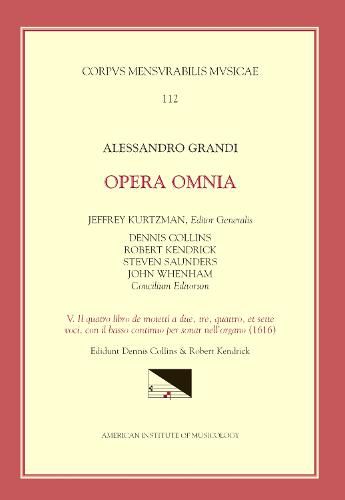Readings Newsletter
Become a Readings Member to make your shopping experience even easier.
Sign in or sign up for free!
You’re not far away from qualifying for FREE standard shipping within Australia
You’ve qualified for FREE standard shipping within Australia
The cart is loading…






Alessandro Grandi (ca. 1586-1630) is best known as the first composer to use a form of the word cantata to describe a set of musical compositions (for his Cantade et arie, ca. 1618) and as Monteverdi’s vice-maestro di cappella at San Marco in Venice during the 1620s. Grandi’s Fourth Book of motets (1616), mainly smaller-scale pieces, contains works that can be linked to his two academic employers in Ferrara, the confraternity-academies of the Spirito Santo and the Morti. Like Grandi’s other prints, this book received multiple reprints, and some of its contents were copied as far away as north Germany and England. The present volume also contains major new biographical findings by Rodolfo Baroncini, and represents the first modern edition of most of the pieces. The series of publications will be edited by an editorial team headed by Jeffrey Kurtzman, in collaboration with Dennis Collins, Robert Kendrick, Steven Saunders, and John Whenham. Grandi’s Fourth Book of motets (1616), mainly smaller-scale pieces, contains works that can be linked to his two academic employers in Ferrara, the confraternity-academies of the Spirito Santo and the Morti. Like Grandi’s other prints, this book received multiple reprints, and some of its contents were copied as far away as north Germany and England. The present volume also contains major new biographical findings by Rodolfo Baroncini, and represents the first modern edition of most of the pieces. For more information, see http: //www.corpusmusicae.com/cmm/cmm\_cc112.htm
$9.00 standard shipping within Australia
FREE standard shipping within Australia for orders over $100.00
Express & International shipping calculated at checkout
Alessandro Grandi (ca. 1586-1630) is best known as the first composer to use a form of the word cantata to describe a set of musical compositions (for his Cantade et arie, ca. 1618) and as Monteverdi’s vice-maestro di cappella at San Marco in Venice during the 1620s. Grandi’s Fourth Book of motets (1616), mainly smaller-scale pieces, contains works that can be linked to his two academic employers in Ferrara, the confraternity-academies of the Spirito Santo and the Morti. Like Grandi’s other prints, this book received multiple reprints, and some of its contents were copied as far away as north Germany and England. The present volume also contains major new biographical findings by Rodolfo Baroncini, and represents the first modern edition of most of the pieces. The series of publications will be edited by an editorial team headed by Jeffrey Kurtzman, in collaboration with Dennis Collins, Robert Kendrick, Steven Saunders, and John Whenham. Grandi’s Fourth Book of motets (1616), mainly smaller-scale pieces, contains works that can be linked to his two academic employers in Ferrara, the confraternity-academies of the Spirito Santo and the Morti. Like Grandi’s other prints, this book received multiple reprints, and some of its contents were copied as far away as north Germany and England. The present volume also contains major new biographical findings by Rodolfo Baroncini, and represents the first modern edition of most of the pieces. For more information, see http: //www.corpusmusicae.com/cmm/cmm\_cc112.htm